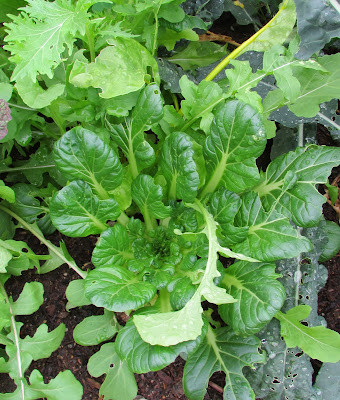Beautiful rain earlier today, it's warm at 63 degrees, and a perfect afternoon for weeding in the winter vegetable bed. I took a lot of pictures to keep my blog up-to-date to review for next year.
 |
| Paw Print |
I did a second planting a little over a week ago and the seedlings are coming in. My neighbors' dog likes to come by late in the evening and use one of our birdbaths for his drinking bowl; I don't mind that as much as I mind that he takes a short-cut through the newly planted area of the lettuce patch. Paw prints that size can push the seeds so far down that they will not find their way to the light to sprout. This is the second time he has walked though it, the first time he was digging too. I had to reseed most of these beds, who knows what will come up in what row now. At least they are salad greens and if they are mixed up it won't matter. I can identify them as they come in and transplant if need be to give them more room. I did try the first time to space the seeds of the head lettuces: Speckles, Oak Leaf, Red Sails and Romaine, so they would have enough room to form a good size head, but...oh well, if that is all I have to complain about I am one lucky gardener. I should have covered them the first time!
 |
| Lacinato Kale, still some damaged leaves from the worms, but new growth looks free of holes. |
On a positive note, my kale is coming back! When the weather was still warm the white butterflies were still around and laid their eggs so we had worms that devoured the leaves. We still ate the parts they left us, I am not bothered by holes left from freeloading moochers.
The peas and snow peas are making their way up the old tomato cages. I did have to add a few thin, cane poles to support them when small, but I think this will work out very well for me and make it easy to harvest. I have more growing in another area and I picked a few snow peas today.
Yellow string beans and green beans, both are bush type.
We have blossoms!
Arugula
I am harvesting all of the greens now, picking just what we need each day for our salads. It is amazing how little amount of space one needs to grow their own lettuce. You can even grow them in shallow wood boxes. Line the bottom with many layers of newspaper to keep the soil from running though, sprinkle the top soil with the seeds and dust lightly with soil, press down and sprinkle with water once a day to keep the seeds moist. In just a few weeks you will have your own salad greens to cut. Also the greens continue to grow new leaves, try to harvest from the outside in and leave a few in the center to grow. I do this even with the head type lettuces, not Iceberg mind you, but the types I am growing here.
If more people would set up small gardens in their backyards, we would not have so many unhealthy people, and it costs cents on the dollar compared to the $4.00 bags you buy in the market for gourmet greens. You can grow your own for as little as $1.89. That seed packet will supply your family with enough greens for the season. You will be amazed at the flavors, many people that we share ours with said they had no idea that it tasted so different and so much better than what they buy even at the farmer's markets. I think it is because ours is grown out in the open and not in green houses or hot houses with liquid fertilizers running through the watering mechanism that are used in mass grown facilities. We only use organic fertilizer and it is not liquid. We blend our own which I mix in the soil before I plant. I rarely need to fertilize more than once during the long growing season. The winter rains help immensely in nourishing the garden, another reason it taste better than what is grown in greenhouses.

Spicy Salad Mix
This is Tatsoi (taht-SOY), an Asian green in the brassica family. I add this to the salad mix but also like to use it in the same way you would baby bok choy. This plant can have a peppery note to it, but with the mild winters we have, it remains sweeter. It really took off when we had the rain a few weeks back and today it looks like it is loving this cooler rain.
More of the spicy salad mix from Botanical Interest seeds. See the link of have on the right side of my blog, look for the Mesclun Farmer's Market blend or Sassy Salad blend.
The second planting of Lacinato Kale on left.
Sorrel
Second planting of onions
Swiss Chard
More onions, I also have Swiss Chard seeded in here that should be coming up soon. The onions will be harvested by the time the plants need the room. I like to put onions in amongst my seeds when planting, I use onion sets and they come up quickly.
These are onions I am growing from last years seed heads that I saved. I will transplant them in the next week or so to give them more room. If you have ever transplanted onion seedlings you know it is torture on your back and knees.
Well that's about it for now. I will leave you with St. Francis in the garden, watching over the hibiscus plant and keeping a close eye on all the little ones, protecting them from visiting cats and dogs.










 .
. 





























.JPG)
.JPG)
.JPG)






























